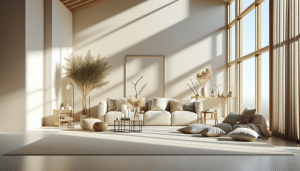Minimalist Living Ideas You Might Not Have Tried
Jessica White September 9, 2025
Curious how minimalist living can refresh your home and mindset? Discover practical minimalist living ideas with a creative twist. This guide shares clever space-saving, decluttering strategies, and sustainable choices that transform daily routines and well-being in surprising ways.
The Appeal of Minimalism in Everyday Life
Minimalism isn’t just about having less; it’s about making room for more of what matters. People everywhere are drawn to the movement—not just for decluttering, but also for peace of mind. Minimalist living ideas often begin with the intention to simplify. This means intentionally curating belongings and routines, which can release stress and create a sense of calm. By removing distractions, the minimalist approach encourages a focus on experiences rather than objects, helping many rediscover joy in small daily rituals and shared moments.
Cluttered spaces can lead to a cluttered mind. Minimalist interiors—often characterized by clean lines, neutral colors, and open floor plans—can promote feelings of relaxation. Researchers have shown that organized environments may help lower anxiety and support mental clarity (Source: https://www.nimh.nih.gov/health/topics/anxiety-disorders). Reducing excess items can make cleaning simpler, save time, and free up energy for creative pursuits or personal connections. The minimalist lifestyle values quality over quantity: fewer items, but ones that truly serve a purpose or bring joy.
Beyond appearances, the philosophy extends to how minimalists spend their time and money. Prioritizing purposeful purchases and conscious consumption improves not only the look of spaces but also financial wellness. Minimalists often find increased satisfaction in experiences, nature, and hobbies—choices that can spark greater happiness according to positive psychology research. Adopting minimalist living ideas is a personal journey; it looks different for everyone, but the benefits often ripple throughout all aspects of life.
Decluttering Methods That Actually Work
The first step toward minimalist living is tackling clutter head-on. One popular method is the ‘one-touch rule’: handle each item only once, deciding immediately if it stays, goes, or needs attention. This minimizes piles and indecision, creating momentum for deeper decluttering sessions. Many people start with visible areas—countertops, entryways, or closets—to create a sense of progress. Visible changes can be motivating, providing quick wins and encouraging continued effort.
Another effective approach is the ‘category method.’ Instead of working room-by-room, sort items by category—like clothes, books, or kitchen gadgets. Sorting by type often reveals duplicates or unused items. The KonMari Method, which emphasizes keeping what ‘sparks joy,’ is one example that has inspired millions. It helps shift thinking from what to discard, to what to cherish. Studies support the psychological benefits of this method, showing that intentional choices can reduce decision fatigue and boost happiness (Source: https://www.apa.org/topics/mental-health/decision-fatigue).
Sustainable decluttering includes donating, recycling, or selling items rather than sending them straight to landfill. Many communities offer local organizations or online marketplaces to ensure your useful items find new homes. These actions not only align with minimalist values but also contribute to environmental sustainability, making the entire process more rewarding (Source: https://www.epa.gov/smm/sustainable-management-materials-non-hazardous-materials-and-waste-management-hierarchy).
Creative Storage for Small Spaces
Minimalism works for every size home, but small spaces truly showcase its power. Creative storage solutions transform tiny apartments, condos, or rooms into functional and relaxing retreats. Multifunctional furniture—think ottomans with hidden storage, under-bed drawers, or fold-away desks—maximizes every inch. Modular shelves adapt to changing needs, making them perfect for anyone who values flexibility or moves frequently.
Vertical storage adds crucial capacity without increasing clutter. Floating shelves, wall hooks, and hanging baskets utilize wall space for frequently used items, keeping surfaces clear. Open shelving creates display opportunities, so even storage becomes part of the decor. With the rise of remote work, creating organized zones for laptops, paperwork, and supplies has become especially important (Source: https://www.ncbi.nlm.nih.gov/pmc/articles/PMC8652782/). These storage solutions merge style with function—an essential aspect of minimalist living ideas.
Hidden storage is another minimalist favorite. Think benches that open up, headboards with shelves, or staircase drawers. These innovations keep necessities out of sight but easily reachable. By intentionally placing storage, minimalists make daily routines smoother and less stressful. Over time, a thoughtfully organized environment fosters habits that support minimalism and reduce the temptation to accumulate unnecessary items.
Mindful Consumption and Sustainable Choices
Minimalist living connects naturally with eco-conscious habits. Mindful consumption means making intentional choices about what to bring into your home. This can involve researching products, supporting ethical brands, or selecting items made from sustainable materials. Buying less but better quality reduces waste and long-term costs. It curates a home environment that reflects personal values while reducing environmental impact. Sustainable living tips often go hand-in-hand with minimalism.
Meal planning—an often-overlooked area—can also reflect minimalist principles. Planning ahead helps reduce food waste and impulse purchases. Choosing versatile foods and reusing leftovers aligns the kitchen with minimalist and sustainable goals. Studies from leading universities highlight that waste-conscious meal prep can cut grocery bills and support better nutrition (Source: https://www.hsph.harvard.edu/nutritionsource/sustainability/food-waste-solutions/).
Clothing is another key area. Adopting a capsule wardrobe—a curated collection of versatile, high-quality pieces—simplifies decision-making and streamlines laundry. Many embracing minimalist living ideas find they develop a personal style that requires less shopping, saving both time and money. Choosing sustainable fabrics or secondhand clothing also supports environmental goals, making personal style part of a broader movement toward conscious living.
Minimalism and Mental Wellness
Minimalist living isn’t just physical—it’s deeply connected to mental wellness. Research shows that decluttered environments can lower stress hormones and enhance focus. This results in more restful sleep and increased productivity. Reducing visual noise from crowded spaces lets the mind rest and recharge more easily. These benefits can be especially important for people balancing work, family, and personal life.
Practicing minimalism can encourage mindfulness and presence in daily life. Without constant distractions from possessions, it becomes easier to appreciate small joys—like a morning cup of tea, an uncluttered desk, or a book enjoyed in silence. Minimalist routines often include digital decluttering, setting boundaries on devices, and frequent tech breaks. This has been shown to improve well-being and reduce feelings of overwhelm (Source: https://www.apa.org/topics/mental-health/technoference).
Community aspects matter too. Many minimalists report deeper connections with friends or family after removing distractions. Fewer possessions make gatherings simpler. Shared activities—like board games, park picnics, or home-cooked meals—can replace consumer-based entertainment. These choices nourish relationships and create lasting memories, supporting both minimalism and emotional health.
Getting Started with Minimalist Living
Starting a minimalist journey doesn’t require perfection. Many find success by setting small, achievable goals—like organizing a single drawer or skipping one impulse buy per week. Others start by identifying what feels overwhelming and addressing those spaces first. Importantly, the process is flexible. Minimalism can be tailored to individual needs, schedules, and lifestyles. Even minor changes bring rewarding results over time.
Online resources, documentaries, and communities offer guidance and inspiration. Connecting with others on a similar path provides accountability and encouragement. Exploring minimalist living ideas in a group can spark creativity and lasting motivation. Experimenting with routines or storage solutions helps discover what works best. Remember, minimalism is not about deprivation—but about making space for what matters most.
Celebrate milestones, no matter how small. Notice reduced stress, increased focus, or new appreciation for everyday moments. These are concrete rewards that reinforce the practice. Over time, minimalist living becomes a natural part of life, supporting overall well-being in unexpected ways. Explore more strategies as you go, knowing each step is progress toward a more intentional future.
References
1. National Institute of Mental Health. (n.d.). Anxiety Disorders. Retrieved from https://www.nimh.nih.gov/health/topics/anxiety-disorders
2. American Psychological Association. (n.d.). Decision Fatigue. Retrieved from https://www.apa.org/topics/mental-health/decision-fatigue
3. U.S. Environmental Protection Agency. (n.d.). Sustainable Management of Materials. Retrieved from https://www.epa.gov/smm/sustainable-management-materials-non-hazardous-materials-and-waste-management-hierarchy
4. National Center for Biotechnology Information. (2021). COVID-19 and Remote Work. Retrieved from https://www.ncbi.nlm.nih.gov/pmc/articles/PMC8652782/
5. Harvard T.H. Chan School of Public Health. (n.d.). Food Waste Solutions. Retrieved from https://www.hsph.harvard.edu/nutritionsource/sustainability/food-waste-solutions/
6. American Psychological Association. (n.d.). Technoference: The interference of technology in couple relationships and daily life. Retrieved from https://www.apa.org/topics/mental-health/technoference








